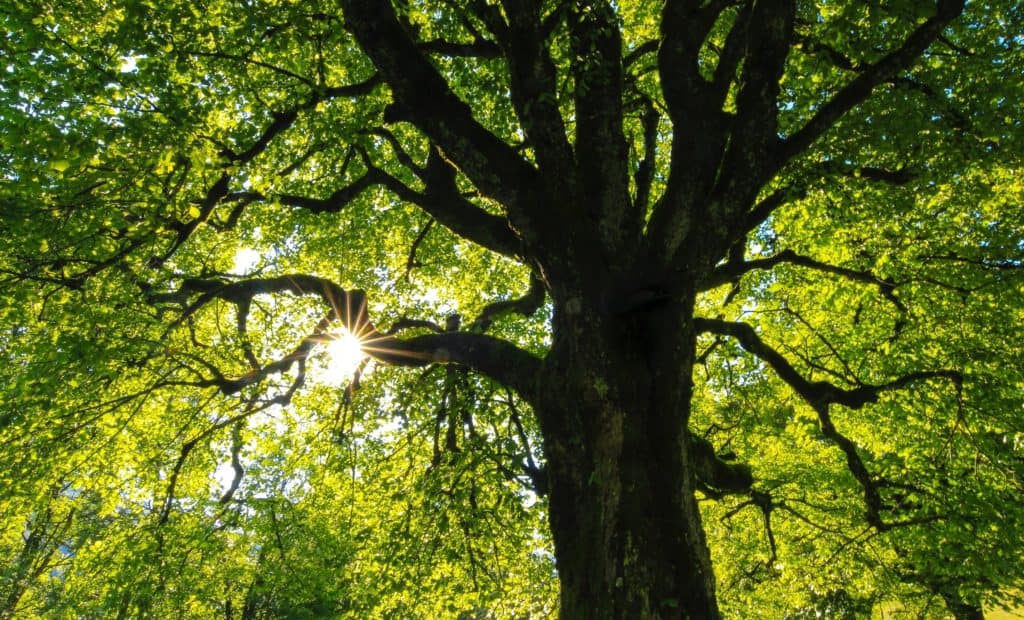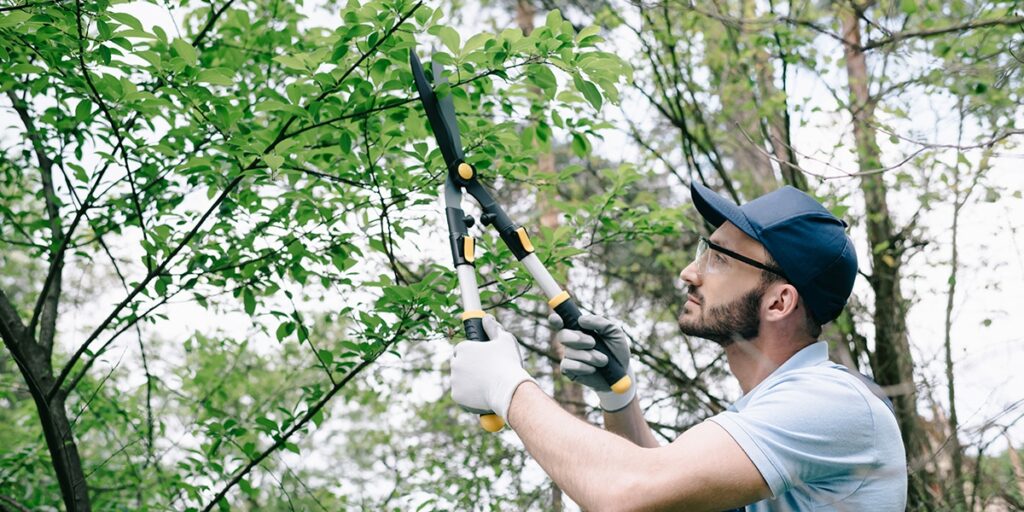By: Shelby McCullough| Published: January 19, 2024
Introduction
Oak trees are a staple in many landscapes due to their majestic size, longevity, and beauty. However, without proper maintenance, their health and appearance can suffer. That’s why trimming oak trees is crucial, not just for their aesthetics but also for ensuring their health and longevity. This Oak Tree Trimming Guide will walk you through the best practices, key techniques, and tips to maintain your oak trees, ensuring they thrive year after year.

Whether you’re a seasoned gardener or new to tree care, this guide offers valuable insights for everyone.
Why Oak Tree Trimming is Important
Promotes Healthy Growth
Trimming oak trees is essential to encourage healthy growth. Removing dead, diseased, or weak branches prevents pests and diseases from spreading throughout the tree.
- Prevents Disease: Proper trimming improves air circulation, reducing the risk of disease.
- Strengthens Structure: Trimming allows the tree to maintain a balanced structure, making it less prone to storm damage.
Enhances Safety
Large oak trees with overgrown or damaged branches pose a hazard to nearby people and property. Trimming reduces the risk of falling limbs.
- Prevents Property Damage: Regular trimming keeps branches away from power lines, roofs, and other structures.
- Improves Visibility: For oaks near driveways or walkways, trimming improves sightlines and safety.

Aesthetic Appeal
Oak trees, when trimmed correctly, enhance the beauty of your landscape. Shaping your tree can also ensure it grows in a way that complements your property.
When is the Best Time to Trim Oak Trees?
Timing is critical when it comes to trimming oak trees to prevent disease and ensure optimal growth.
Dormant Season
The best time to trim oak trees is during their dormant season, typically in late fall or winter. During this time, the risk of disease, particularly oak wilt, is significantly reduced.
- Late Fall to Winter (November – March): This is the safest period for trimming oak trees.
- Avoid Spring and Summer: These seasons increase the risk of oak wilt, a deadly fungal disease that spreads through open wounds.
Signs Your Oak Tree Needs Trimming
- Dead or diseased branches
- Overgrown limbs interfering with structures
- Branches crossing or rubbing against each other
- Limbs hanging low or posing safety risks

Tools Needed – Oak Tree Trimming Guide
To ensure an efficient and safe trimming process, it’s essential to use the right tools. Here’s a list of necessary equipment:
- Pruning Shears: For small branches.
- Lopping Shears: For medium-sized branches (up to 2 inches in diameter).
- Pole Saw: For high branches that are difficult to reach.
- Hand Saw: For branches thicker than 2 inches.
- Chainsaw: For larger, more difficult branches.
- Safety Gear: Gloves, protective glasses, hard hats, and sturdy footwear.
Having the proper tools ensures a smooth and safe trimming process, reducing the chances of injury or damage to the tree.
Step-by-Step Oak Tree Trimming Process
Trimming an oak tree requires careful planning and execution to ensure the health of the tree while preventing damage. Follow these steps for a successful trimming session.
1. Assess the Tree
Before you begin trimming, evaluate the tree to determine which branches need to be removed. Look for:
- Dead or diseased branches
- Branches crossing over each other
- Limbs that pose safety risks
2. Start with Dead or Diseased Branches
Remove any dead or diseased branches first to prevent the spread of disease.
- Cut near the collar (the swollen area where the branch meets the trunk), but avoid cutting into the collar itself to ensure proper healing.
3. Trim Weak and Overgrown Branches
Focus on trimming branches that are weak or overgrown. This ensures that sunlight can penetrate through the canopy, encouraging healthier growth.
- Avoid cutting more than 20% of the tree’s branches in one season. Over-trimming can shock the tree.
4. Shape the Canopy
Once the dead and diseased branches are removed, trim to shape the canopy. Make sure to maintain the tree’s natural shape while removing excess growth.
- Always cut branches at a 45-degree angle to promote quicker healing.
5. Clean Up
After trimming, clean up any debris around the tree. Leftover branches can harbor pests and fungi, posing a threat to the tree’s health.

Common Oak Tree Trimming Mistakes to Avoid
Trimming oak trees requires precision and care. Avoid these common mistakes:
1. Trimming During the Wrong Season
As mentioned earlier, trimming during spring or summer can expose the tree to oak wilt, which can be fatal.
2. Cutting Too Close to the Trunk
Cutting branches too close to the trunk can damage the tree’s collar, leading to slow healing and increased vulnerability to disease.
3. Over-Trimming
Removing more than 20% of the tree’s canopy can stress the tree, leading to poor growth or even death.
4. Using Dirty Tools
Always use clean, sterilized tools. Dirty tools can introduce diseases into the tree.
Oak Tree Health After Trimming: Tips for Recovery
After trimming, proper care is crucial to ensure the oak tree remains healthy and strong.
1. Watering
Ensure the tree receives adequate water, especially if it’s been a particularly dry season. However, avoid overwatering, as oak trees prefer well-drained soil.
2. Mulching
Apply a layer of mulch around the base of the tree (but not touching the trunk). This helps retain moisture and regulates soil temperature.
3. Fertilizing
If your oak tree is showing signs of nutrient deficiency (e.g., yellowing leaves), consider applying a slow-release fertilizer.
4. Monitoring
Keep an eye on the tree over the weeks following trimming. If you notice any signs of stress, such as wilting leaves or oozing sap, contact a tree care professional immediately.
Conclusion
Maintaining your oak trees through regular trimming is essential for their health, safety, and beauty. By following this Oak Tree Trimming Guide, you can ensure your oak trees continue to thrive for generations to come. Remember to use the proper tools, trim at the right time, and avoid common mistakes to protect your tree’s longevity.
For more expert advice or professional tree trimming services, don’t hesitate to contact McCullough Tree Service. Your trees deserve the best care, and we’re here to provide it.
FAQs
What is the best time to trim oak trees?
The best time to trim oak trees is in the winter months, typically from January through March. This is when the tree is in its dormant phase which minimizes the risk of disease spread, such as Oak Wilt, and promotes faster recovery.
What factors should be considered while trimming oak trees?
Several factors should be considered when trimming oak trees, including the specific oak species and its growth habits, the tree’s age and health, correct tool preparation, proper equipment selection, and the timing of the trimming process. It’s also important to follow proper pruning techniques and avoid common trimming mistakes.
What is the best time to trim oak treesΩ
Proper tool preparation involves soaking your tools, such as clippers and saw blades, in a solution of nine parts water to one part bleach and allowing them to air dry. This is important for preventing the transmission of diseases between trees. It’s also crucial to ensure your tools are of high quality and sharp for precise cutting.
What are some common mistakes to avoid while trimming oak trees?
Common mistakes to avoid when trimming oak trees include making heading cuts that disrupt the tree’s natural growth pattern and applying Lion tailing, a pruning technique that yields to excessive foliage loss and stress to the tree. Flush cuts that damage the branch collar and stub cuts leaving excessively long stubs must also be avoided. Instead, employing the three-cut method ensures healthy pruning.
What should I do to prevent oak wilt and other diseases when trimming oak trees?
Limiting pruning to the safer winter months significantly reduces the risk of wound-infesting insects and disease transmission. If pruning cuts are necessary outside the optimal season due to emergencies, using pruning sealants immediately can protect against infections. It’s also important to dispose of diseased branches properly to prevent the spread of oak tree diseases.
What can I do to maintain oak trees after trimming?
Following oak tree trimming, a maintenance plan involving regular inspections by an ISA-certified arborist, proper watering, protection from weeds and undue stress, as well as promotion of strong growth through well-balanced nutrition can all contribute to the post-trimming vitality of oak trees.

